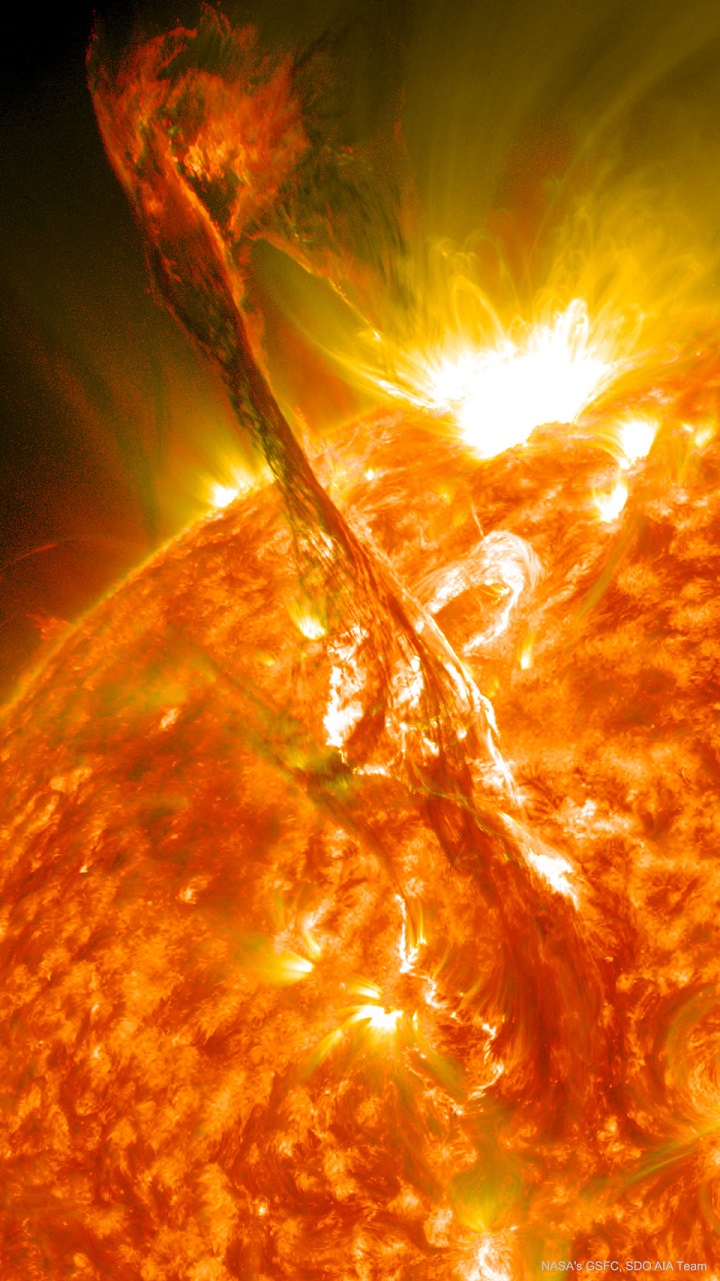A Solar Filament Erupts.
From Nemiroff and Bonnell: Astronomy Picture of the Day – 2018 September 16.

Image Credit: NASA‘s GSFC, SDO AIA Team
Explanation: “What’s happened to our Sun? Nothing very unusual — it just threw a filament. Toward the middle of 2012, a long standing solar filament suddenly erupted into space producing an energetic Coronal Mass Ejection (CME). The filament had been held up for days by the Sun’s ever changing magnetic field and the timing of the eruption was unexpected. Watched closely by the Sun-orbiting Solar Dynamics Observatory, the resulting explosion shot electrons and ions into the Solar System, some of which arrived at Earth three days later and impacted Earth’s magnetosphere, causing visible aurorae. Loops of plasma surrounding an active region can be seen above the erupting filament in the featured ultraviolet image. Although the Sun is now in a relatively inactive state of its 11-year cycle, unexpected holes have opened in the Sun’s corona allowing an excess of charged particles to stream into space. As before, these charged particles are creating auroras.” [Links are from the APOD original.]
(A service of NASA. Discover the cosmos! Each day a different image or photograph of our fascinating universe is featured, along with a brief explanation written by a professional astronomer.)
Astronomy Picture of the Day. Authors & editors: Robert Nemiroff (MTU) & Jerry Bonnell (UMCP).
Also highly recommended, The Solar Dynamics Observatory (SDO) website:
“The Solar Dynamics Observatory is the first mission to be launched for NASA’s Living With a Star (LWS) Program, a program designed to understand the causes of solar variability and its impacts on Earth. SDO is designed to help us understand the Sun’s influence on Earth and Near-Earth space by studying the solar atmosphere on small scales of space and time and in many wavelengths simultaneously.
SDO’s goal is to understand, driving towards a predictive capability, the solar variations that influence life on Earth and humanity’s technological systems by determining
- how the Sun’s magnetic field is generated and structured
- how this stored magnetic energy is converted and released into the heliosphere and geospace in the form of solar wind, energetic particles, and variations in the solar irradiance.”
…
Specs:
“SDO is a sun-pointing semi-autonomous spacecraft that will allow nearly continuous observations of the Sun with a continuous science data downlink rate of 130 Megabits per second (Mbps). The spacecraft is 4.5 meters high and over 2 meters on each side, weighing a total of 3100 kg (fuel included). SDO’s inclined geosynchronous orbit was chosen to allow continuous observations of the Sun and enable its exceptionally high data rate through the use of a single dedicated ground station.” (https://sdo.gsfc.nasa.gov/mission/)
A large range of images, videos, and explanatory texts about the SDO are available on the website. (https://sdo.gsfc.nasa.gov/) The area called “The sun now” indicates the site’s update frequency.

